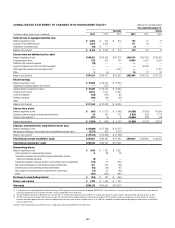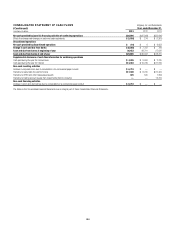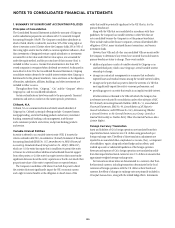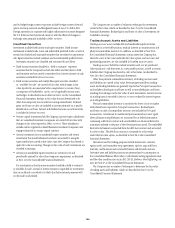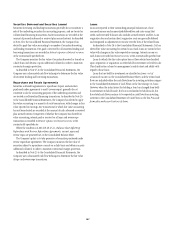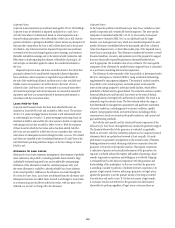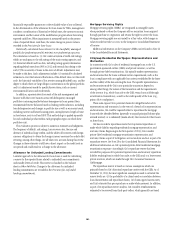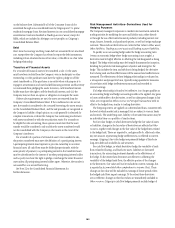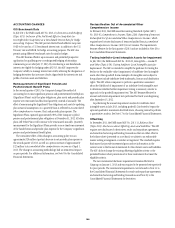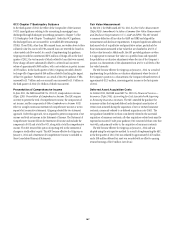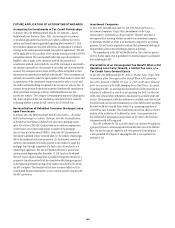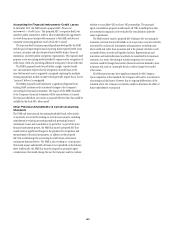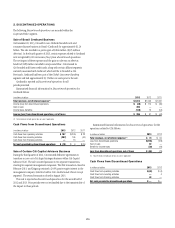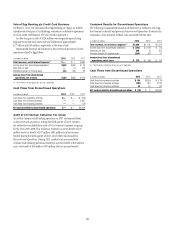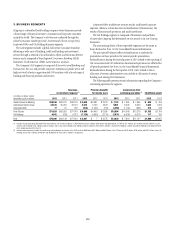Citibank 2013 Annual Report Download - page 180
Download and view the complete annual report
Please find page 180 of the 2013 Citibank annual report below. You can navigate through the pages in the report by either clicking on the pages listed below, or by using the keyword search tool below to find specific information within the annual report.162
on Citi’s analysis of its most recent collection trends and the financial
viability of the third-party sellers (i.e., to the extent Citi made representation
and warranties on loans it purchased from third-party sellers that remain
financially viable, Citi may have the right to seek recovery from the third
party based on representations and warranties made by the third party to Citi
(a “back-to-back” claim)).
In the case of a repurchase, Citi will bear any subsequent credit loss on
the mortgage loan and the loan is typically considered a credit-impaired
loan and accounted for under AICPA Statement of Position (SOP) 03-3,
“Accounting for Certain Loans and Debt Securities Acquired in a Transfer”
(now incorporated into ASC 310-30, Receivables—Loans and Debt
Securities Acquired with Deteriorated Credit Quality) (SOP 03-3).
In the case of a repurchase of a credit-impaired SOP 03-3 loan, the
difference between the loan’s fair value and unpaid principal balance at the
time of the repurchase is recorded as a utilization of the repurchase reserve.
Make-whole payments to the investor are also treated as utilizations and
charged directly against the reserve. The repurchase reserve is estimated
when Citi sells loans (recorded as an adjustment to the gain on sale, which is
included in Other revenue in the Consolidated Statement of Income) and is
updated quarterly. Any change in estimate is recorded in Other revenue.
Goodwill
Goodwill represents the excess of acquisition cost over the fair value
of net tangible and intangible assets acquired. Goodwill is subject to
annual impairment testing and between annual tests if an event occurs
or circumstances change that would more likely than not reduce the fair
value of a reporting unit below its carrying amount. The Company has an
option to assess qualitative factors to determine if it is necessary to perform
the goodwill impairment test. If, after assessing the totality of events or
circumstances, the Company determines that it is not more likely than not
that the fair value of a reporting unit is less than its carrying amount, no
further testing is necessary. If, however, the Company determines that it
is more likely than not that the fair value of a reporting unit is less than
its carrying amount, the Company is required to perform the first step
of the two-step goodwill impairment test. Furthermore, on any business
dispositions, goodwill is allocated to the business disposed of based on the
ratio of the fair value of the business disposed of to the fair value of the
reporting unit.
Additional information on Citi’s goodwill impairment testing can be
found in Note 17 to the Consolidated Financial Statements.
Intangible Assets
Intangible assets—including core deposit intangibles, present value
of future profits, purchased credit card relationships, other customer
relationships, and other intangible assets, but excluding MSRs—are
amortized over their estimated useful lives. Intangible assets deemed to
have indefinite useful lives, primarily certain asset management contracts
and trade names, are not amortized and are subject to annual impairment
tests. An impairment exists if the carrying value of the indefinite-lived
intangible asset exceeds its fair value. For other intangible assets subject to
amortization, an impairment is recognized if the carrying amount is not
recoverable and exceeds the fair value of the intangible asset.
Other Assets and Other Liabilities
Other assets include, among other items, loans held-for-sale, deferred tax
assets, equity method investments, interest and fees receivable, premises
and equipment, repossessed assets, and other receivables. Other liabilities
include, among other items, accrued expenses and other payables, deferred
tax liabilities, and reserves for legal claims, taxes, unfunded lending
commitments, repositioning reserves, and other matters.
Other Real Estate Owned and Repossessed Assets
Real estate or other assets received through foreclosure or repossession are
generally reported in Other assets, net of a valuation allowance for selling
costs and subsequent declines in fair value.
Securitizations
The Company primarily securitizes credit card receivables and mortgages.
Other types of securitized assets include corporate debt instruments (in cash
and synthetic form) and student loans.
There are two key accounting determinations that must be made
relating to securitizations. Citi first makes a determination as to whether the
securitization entity would be consolidated. Second, it determines whether
the transfer of financial assets to the entity is considered a sale under GAAP. If
the securitization entity is a VIE, the Company consolidates the VIE if it is the
primary beneficiary (as discussed in “Variable Interest Entities” above). For
all other securitization entities determined not to be VIEs in which Citigroup
participates, a consolidation decision is based on which party has voting
control of the entity, giving consideration to removal and liquidation rights
in certain partnership structures. Only securitization entities controlled by
Citigroup are consolidated.
Interests in the securitized and sold assets may be retained in the form
of subordinated or senior interest-only strips, subordinated tranches, spread
accounts and servicing rights. In credit card securitizations, the Company
retains a seller’s interest in the credit card receivables transferred to the trusts,
which is not in securitized form. In the case of consolidated securitization
entities, including the credit card trusts, these retained interests are not
reported on Citi’s Consolidated Balance Sheet. The securitized loans remain


